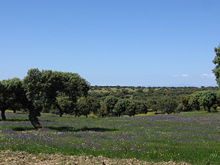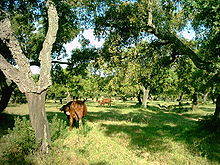- Dehesa (pastoral management)
-
Dehesa is a type of wooded pastureland found in the Iberian peninsula, used for the grazing of livestock (from Castilian for "pastureland"). Dehesas are communal property (usually belonging to the municipality), where residents can also obtain non-timber forest products such as wild game, mushrooms, and firewood.
Contents
Nature
The dehesa is derived from the Mediterranean forest ecosystem, consisting of pastureland featuring herbaceous species for grazing and tree species belonging to the genus Quercus (oak), such as the holm oak (Quercus ilex), although other tree species such as beech and pine trees may also be present.
 Dehesa in Extremadura, Spain
Dehesa in Extremadura, Spain
Importance
The dehesa system has great economic and social importance on the Iberian peninsula because of both the large amount of land involved and its importance in maintaining the rural population levels. The dehesa system has reduced the flow of emigration and its consequences (aging, increased mortality rates, lower birth rates, abandonment of farms, etc.)[citation needed].
Economic context
The exploitation of the dehesa usually coincides with areas that could be termed "marginal" because of both their limited agricultural potential (due to the poor quality of the soil) and the lack of an industrial fabric, which boils down to isolated agro-industries and very small capitalization.
Extension in the Iberian peninsula
Dehesas encompass nearly 20,000 square kilometers on the Iberian peninsula, mainly in:
Spain
- Córdoba
- Extremadura
- Salamanca
- Seville
- Sierra Morena
- Sierra Norte de Huelva
Portugal
- Alentejo
- The Algarve
Other uses of the term
Dehesa also refers to the type of rangeland management of estates for private agro-livestock exploitation in Mediterranean-type forests from which multiple resources are obtained simultaneously.
See also
- Cabañeros National Park
- Wooded meadow
References
Categories:- Geography of Spain
- Agriculture in Spain
Wikimedia Foundation. 2010.

